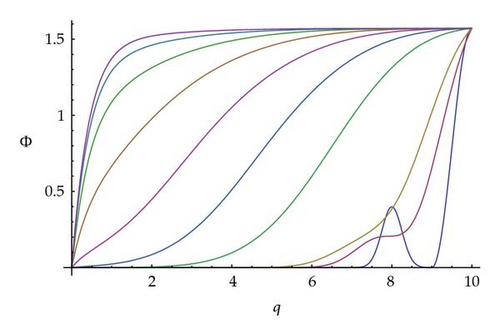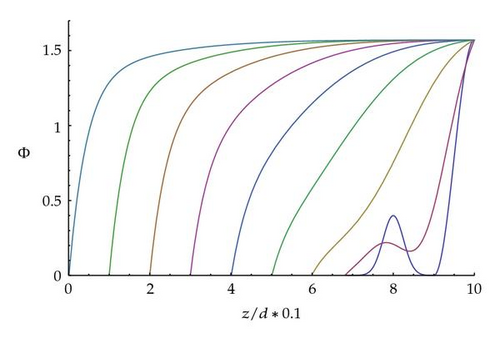A New Solution for the Director Relaxation Problem in Twisted Nematic Film Based on Wavelet Analysis
Abstract
The present research considers and explains the application of the Haar wavelets as basis functions in solution of the propagation of perturbations in low-dimensional anisotropic media. The computations of the relaxation problem in the form of traveling waves have shown that the present approach possesses several advantages over regular methods.
1. Introduction
Not to mention that the study of such non-Newtonian fluids as liquid crystals (LC) has lead to the commercial production of widely used electronic devices, the theory of LC still has a few problems, whose solution presents a difficulty. The problem of a director relaxation in twisted nematic cells (TNCs) in the form of nonlinear waves still remains unsolved. TNCs are integral parts of liquid crystal displays, which are used in laptops and personal computers. TNC is a drop of LC placed between two parallel surfaces, separated by a spacer, and arranged in such a way that the director in the upper surface n+ of the liquid crystal cell is perpendicular to the director in the lower surface n−; in this case, the director always lies in the plane parallel to the two bounding surfaces. In the absence of an external electric field, a linear director field distribution is characterized by the azimuthal angle Φ = (π/2)z and governed by van der Waals′ forces [1, 2]. Here, Φ is the azimuthal angle formed by the director and the X-axis lying in the same plane, the Z-axis is perpendicular to the bounding surfaces, and the origin of the coordinate system is located at the lower surface of the twisted nematic cell. In response to an external electric field E = Ej aligned parallel to the two bounding surfaces along the Y-axis, the twist re-orientation of the director field occurs toward the external electric field. The threshold value of the external electric field, when nonlinear relaxation mechanisms of the director field can occur, we will denote as Ecr.
The use of TNC in production of LC monitors provided a strong encouraging stimulus for intensive research in this field. The present paper shows that angular moments acting on a unit element of nematic LC can generate traveling waves along the Z-axis. This problem can be easily reduced to the solution of dimensionless parabolic partial differential equation.
The goal of the paper is to present the director relaxation problem using the Haar wavelet method [3]. The earlier effort for the solution of this problem was realized in [2]. However, the considered mathematical model does not take into account the perpendicularity of the directors′ orientations located in the plane of bounded plates at the initial moment t = 0.
Methods of wavelet analysis adapted for the solution of partial differential equations have been actively developing in the past 15 years. The advantages of the application of wavelets for the solution of differential problems over regular numerical methods consist of linearly increasing computational costs because of the sparsity of intermediate matrices. Moreover, the quality of solutions obtained by analytically defined basis functions always exceeds classical numerical methods.
2. Problem Formulation
3. Haar Wavelets
From all families of wavelets, we can distinguish a few easily defined functions, which represent a powerful tool in the solution of partial differential equations. Such wavelets are: Shannon wavelets [5], harmonic wavelets [6], and Haar wavelets. The latter wavelets are wellstudied in [3, 7, 8] and references therein.
4. Solution of the Base Equation
It is obvious to present a question about our choice of basis functions. As we know, many other bases exist, which could be suitable for the solution of this problem. The answer to this question should be originated from the limited opportunities of disclosure of the angle between two directors located in parallel planes, and separated by distance Δz(Δq*). It thus appears the discretization of the space variable, and the plot of Φ(τs, q) can be presented by means of scaling functions pi(q) and ri(q) without any losses of the corresponding data.
The solution of (2.3) with initial and boundary conditions (2.4) in the moving coordinate system was obtained by the Haar wavelet method and was illustrated in Figure 1. The initial disturbance of the director′s field in a TNC was generated close to the top plate.

The simulations have shown that this approach for the problem of relaxation of a director toward its equilibrium position allows its the computation of different dynamic modes in TNC. The relaxation of a director with respect to the laboratory coordinate system is shown in Figure 2.

The criterion for relaxation of a director was chosen in the form: ɛ = |Φ(τs+1) − Φ(τs)| ≤ 10−4. In other words, if the azimuthal angle between two time steps is less than ɛ, then the algorithm stops. It is worth emphasizing that the Haar wavelet method permits to get solutions with a smaller error. However, in this case, lower values of ɛ do not play any significant role and only increase the CPU load.
5. Conclusions
The present paper describe the phenomenon of spatial relaxation in a TNC for the case of strong anchoring of LC molecules with the bounded plates. It was suggested to employ the Haar wavelet method for getting a function, which describes the evolution of the azimuthal angle. The advantage of such an approach over regular methods is that the unknown function is searched as a superposition of analytically defined functions, which constitute a complete basis in the L2[0; 1] space. Another reason for our choice of basis functions is low computational costs conditioned [8] by the sparsity of matrix as(i).
Acknowledgments
The work of A. A. Kudreyko is supported by the Istituto Nazionale di Alta Matematica Francesco Severi (Rome-IT) under scholarship U 2010/000139, 1 October 2010. A. A. Kudreyko is thankful to Professor Carlo Cattani (University of Salerno) for many valuable discussions.




